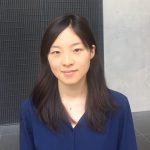Home University: The University of Tokyo
Field of Study: Bioinformatics and Systems Biology
Status: B3 Expected Graduation: March 2019
Research Host Lab: Prof. Junghae Suh, Department of Bioengineering
Why Nakatani RIES?
The two main reasons why I applied to the Nakatani RIES program is that I believe it will help me think about my career as a research scientist and that it would broaden my horizons. In Japan, many people believe the research environment in the US is quite different from that of Japan, and that experiencing research there would be a big plus for one’s career. Experiencing this for myself through this program would help me decide whether I should study abroad in the future for graduate or post graduate studies. I am also curious about the careers of female researchers and the challenges they may face. The number of female researchers in Japan is still limited and I cannot help but anticipate my future in such environment. In the US, there is much research done in computational biology, which I’m majoring in, and I wish to experience such atmosphere where it is so appreciated as well.
I also wish to broaden my horizons by learning about the various research done at Rice University, including research in areas that I am not yet familiar with; meeting people from different backgrounds and communicating with them; experiencing things new to me including food and culture. I believe this program is an invaluable opportunity for undergraduate students to experience research in the US. It will support students who love science, refuel their passion for it, and encourage them to pursue their dreams.
- Practice to explain things logistically using English in an easily understandable way.
- Learn about the career path for researchers in the US.
- Experience various cultures and communicate with many people with different values.
-
Be inspired.
Excerpts from Nina’s Weekly Reports
- Week 01: Arrival in the U.S.
- Week 02: First Week in My Research Lab at Rice
- Week 03: Interview with a U.S. Researcher
- Week 04: Reflections on English Language & Life in the U.S.
- Week 05: Research in the U.S. vs. Research in Japan
- Week 06: Final Week at Rice & Research Poster Presentation
- Week 07: Visit to Lehigh University & Return to Japan
- Final Report & Tips for Future Participants
Week 01: Arrival in the U.S.
As a part of the opening ceremony in Tokyo, we attended a lecture by Dr. Nishikawa on the importance of life science in the 21st century, and Prof. Ida on PhD careers. Although they were both very interesting, I particularly appreciated the one by Dr. Nishikawa as his topics was directly related to my current major. I was lucky enough to talk to him over lunch, and asked him advice about pursuing a career in research related to immunology. This is not only what my interest is in but is also what Dr. Nishikawa specialised in early in his career. Surprisingly, he told me that he would advise me not to go into that particular field, but to pursue other interesting areas such as the brain, as there isn’t much left to study. He also stressed that I should keep my mind open for topics seemingly unrelated to my specialty, as I might happen across a research topic that inspires me to pursue, or to collaborate with others. I was enticed by immunology since the first time I learned about it in high school, and hearing not exactly encouraging things about it from a well-known researcher of that field made me really think and doubt my passion for it. During this program, I will be doing research about viruses. Virology is closely related, or is even a part of immunology in the sense that viruses meddle with, and elegantly circumvents the host immune system. Through studying about viruses and doing research, I intend to rethink about my interests in immunology, and keep my eyes open for new fields of study to broaden my perspectives as Dr. Nishikawa advised and this is obviously a helpful thing.

What surprised me about Houston is its humidity. For some reason, I assumed Houston would be hot but without humidity, like in a desert. My friends at home even texted me on the night of my arrival asking me whether I had seen any cowboys yet. As it turns out, Texas doesn’t even have a desert. On the contrary, the area in Houston where we are staying is greener than any other city I have been to in Japan; the park I saw from my window turned out to be a residential area. And of course, Houstonians being super friendly is hard to miss. When I went to Sydney, Australia couple of years ago, I was surprised that complete strangers walking down the street would smile at me when passing by. But Houstonians are even friendlier. They don’t just smile, but really beam at me. They also never fail to voice a greeting, asking me how I am. This is especially a surprise to me as those who live in Tokyo are a quiet, shy and conservative bunch. While I am here in Houston, seemingly the friendliest city in the country, I would try and be as friendly as the others so as not to be rude. As they say; when in Rome, do as the Romans do.
On Wednesday, our first full day in the US, we had orientations and a very helpful but hot campus tour. The next day we attended general and bio-safety lab training, and later on Prof. Kono and Sarah gave us a

lecture on research in the US and intercultural communication respectively. Prof. Kono insisting that it would be better for us to go to the US as a full-time student as earliest possible was interesting, because normally I hear people saying that there are many paths possible and each has a full set of its own advantages and disadvantages.
On Saturday, I went to Minute Maid Park to watch the Astros vs Athletics game with some other Nakatani fellows. As a fan of baseball, I was very excited. Compared to the games in Japan, I felt that this one had a speedy feeling to it, which may be due to the pitchers throwing faster balls, or how swiftly the teams switch places after each inning. To our delight, the Astros won the game by 3-2. It was an great experience but would have been perfect if Nori Aoki, who I am a fan of, was still with the Astros (He was traded to Toronto Blue Jays at the end of last month).
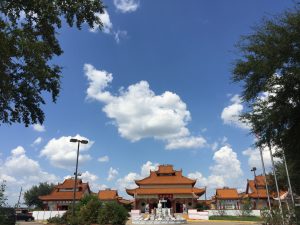
One afternoon, I went to Chinatown using the local bus system. It took about an hour to get there but it seemed to cost us only $1.25 which was amazing compared to Uber. Me and my friend imagined Chinatown to be something similar to the one in Yokohama, Japan, with many small family-owned stores lined up on both sides of a street. The Chinatown in Houston turned out to be more like Rice Village, with a several dozen stores surrounding a parking lot and one huge Chinese grocery store. The grocery store had many Chinese products, and surprisingly, I felt more at home and relaxed than I felt at H-mart, the Korean store. This may be because I have been to China but not to Korea. This was especially interesting for me because before I started learning Chinese and went to China, I never felt a particular liking for Chinese culture including its cuisine. After this program, I may even feel nostalgia for American food. After we left the grocery store, we asked whether there was a place for sightseeing, like a temple, and it turned out there wasn’t any. We then searched on google map and learned that there indeed was a temple but was a 20-minute ride from where we were. We rode the bus and walked for a very hot 10 minutes under the blazing sun and finally got to the temple! The lesson I learned from this experience is that things are not always what you expect to be, and that culture may be acquired.
Preparing for Research in the U.S.
Before arriving at Rice, I contacted my mentor who recommended some papers for me to read. For future participants, I would advise them that the sooner they start reading the papers the better, and that they should start by reading literature reviews to help them grasp a general understanding of the topic.
Question of the Week
Why are the bathroom doors so small? It seems quite easy to peek from above the door. As the ones in Japan covers more area from top to bottom, the ones here do not feel private enough to me.
- Yes, this is a common complaint that many foreigners have about bathrooms in the U.S. If you Google Public Bathroom Doors in the U.S. you’ll find many funny comments about this same problem.
- America, Why Are There Huge Gaps at the Bottom of your Bathroom Doors? (Buzzfeed)
- 7 Answers to Why Public Restroom Doors have Gaps
- Video: Why Japan’s Public Bathrooms Put America to Shame
- 12 Awesome Features of Japanese Bathrooms you Won’t Find in the West (Japan Today)
- Why Japanese Toilets are Failing in the U.S. (Tofugu)
- Also, tubs in the U.S. are typically much shallower and longer than in Japan where deep-soaking tubs are standard. In the U.S., where ‘time is money’ most people prefer to take showers which are faster (typically in the morning) rather than take a long hot bath at night. In many hotel rooms in the U.S., there won’t even be a tub, just a shower.
Week 02: First Week in My Research Lab at Rice
There are five undergraduate students in my host lab, who are all in the same year as I am, and are all very friendly. On my first day, two of the undergraduates, Kiara and Joanna, were in lab, and they showed me around and talked me through the completed/ongoing projects of the lab. This was very helpful because although I had read about many of the projects prior to my arrival from the papers my mentor recommended, I did not feel like I understood the concepts introduced in full as there were many field specific terms used. My host lab is at the BRC, BioScience Research Collaborative, which is located between Rice University’s main campus and the Texas Medical Center. It may be due to its collaboration promoting nature, or just unique to my floor, but on the walls of the hallway connecting the student’s office and the lab, there are posters about prior research done by the labs on that floor. Kiara and Joanna used those posters to explain the projects to me, which made it considerably easier for me to grasp the concepts. I experienced for myself just how much a figure is helpful to an outsider, and made a mental note to put nice pictures or figures on my own poster so that my audience would hopefully, like me, have an easier time understanding my project when I present it in the final week. The other lab members were all very friendly and welcoming as well. Interestingly, it may be because Prof. Suh is a female as well, but more than half of the lab members are women. I believe one would be hard pressed to find such a lab in Japan.
My mentor, Nikki, is a fourth-year PhD candidate and has a very sharp minded but is also a kind and friendly person. She seems to have a lot of experience with undergraduates, and has a realistic view of what I can and should learn during my short stay, which I very much appreciate. It is also hard to miss how organized and efficient she is with her lab work. This is currently my top priority of things to learn while I am here, as biology-related lab work tends to be tedious and time consuming. This is one of the things I anticipated when considering a career in this field. As far as I have observed, proficient use of technology and careful planning seems to be a part of her secret.
Explaining something in a scientific context is something I need to practice and learn. This is partly because I have hardly ever studied science, especially math, in English. For example, when you are mixing substances in chemistry, you would probably say something like “mix a and b in a ratio of 3:1”. This is a sentence you would not learn at an English class. However, it is possible to come across such phrase in a book or paper and thus learn it. Interestingly, the part I had the most trouble with was reading “3:1” as “three to one”. I obviously understand what the symbols mean, but did not know how to read them aloud and felt for a split second like a seven-year-old. Luckily, my mentor talks me through what she is doing when we are in the lab, so I watch and listen, both for the science and the language.
At the end of the week, I have come to conclude that my conversational English is sufficient to manage life and keep away from eminent danger in an English-speaking country, but rather I sometimes do not know what I should say regardless of the language. Suppose a graduate student was talking to me about something non-work-related. In Japan, I would just kindly agree with them or even flatter them a little because they are older, and such respect is expected of me. Here, undergraduates in the same circumstance may give the elders their advice or if they are agreeing, they will do so very enthusiastically using frank words. For now, I still feel awkward not knowing how to react or comment on people’s words but as Sarah said, I believe I would have to “feel my way” by observing and experimenting.
This week we also had a seminar on how to design and develop a poster and lab safety training. Because the lecturer spoke to us in an engaging way and did not just read off her notes, the lab safety training was surprisingly enjoyable compared to those in Japan. It was also helpful to have the poster presentation session before we started with our projects because then we would know what our goal is.
Besides research, one evening we went to the Houston Museum of Natural Science. They had an extensive taxidermy display, which I enjoyed. I was also excited to see the exhibition centering the ecology of Texas’s gulf coast. As I am fascinated with ecology, I spent a lot of time here studying the exhibits. Overall, this opportunity made me remember once again what made me enthralled with science in the first place; my love and curiosity towards mother nature and its mysterious beauty.
I also went to the Cheesecake Factory, which was recommended by past Japanese fellows. I love cheese and sweets, and felt a swarm of pure happiness for the first few bites; but the cakes were in American size and were just too much for even me. But still, the cakes were great, and I highly recommend anyone who likes cheesecakes to try it out at least once.
Research Project Update
My mentor is examining whether a model called Protein Frustratometer that calculates the local energetic stability of a given protein conformation, may be applied to proteins consisting viral capsids in AAV, Adeno Associated Viruses. This is done by first identifying amino acids of the capsid protein with an unique energetic trait, and then replacing them with a neutral amino acid and examining the effect. I would probably help confirming the model’s credibility for one or two amino acids predicted to have be energetically neutral, as a control experiment. This means that if the viruses I modified had different characteristics compared to the unmodified ones, the whole credibility of my mentor’s project would become questionable. But that was just me being dramatic, and I believe the results would turn out okay.
The project would require bioengineering techniques such as designing plasmids (calculating what kind of mutation to introduce to change the amino acid), transfection (amplifying plasmids, which are circular DNAs) and transduction (introducing the viruses into the cell). We will also need to quantify the DNAs by using techniques such as qPCR. I have experienced these before, but not with mammalian cells which I hear is considerably more complicated to work with. Moreover, at school we were given a book with methods used for decades in the course, and we were to just follow them. But the method used in my mentor’s research is what she thought of, and it is interesting to think over, and sometimes ask, all the reasons and logic behind her choosing each procedure.
For now, I am more focused on reading papers and understanding the theory the project is based on. The Frustratometer uses an unique concept called “frustration” which is originally a term used in condensed matter physics, and is probably the model’s namesake. A protein region which is minimally frustrated would presumably comprise a stable folding core, whereas a highly frustrate region would be involved in binding with other proteins. Further, the Frustratometer’s calculation is based on a model called AWSEM, which, according to my understanding, predicts the tertiary structure of a given protein based on its amino acid sequence and environment. It is relevantly easy to vaguely grasp the concept of frustration and AWSEM, but it is considerably difficult to understand it enough to explain it to another person, which I would have to do at my poster presentation. Moreover, since I am a natural science student and not an engineer, I tend to be inclined to understand the theory as much as possible before considering its application, or just using them in general. And because this time, the concepts are those of biophysics, which I have circumvented in the past, there is a lot for me to learn. On the bright side, this is a better opportunity than any for me to get to know about the field, as I have an excellent mentor to help me when I am in need.
Question of the Week
This weekend, we unfortunately experienced hurricane/tropical storm Harvey and saw on TV the numerous floods it caused around Houston and Harris county. In Japan, especially in a developed city like Tokyo, we have drains every several feet along each road no matter how narrow it may be. These drains are connected to huge underground tunnels and vast space which are designed to store the excess water until we can safely drain them through our conventional drainage systems. As a result, although flooding of rivers is sometimes a problem, but other areas are mostly safe. Conversely, I have noticed that such road drainages are not prevalent here, and have also heard tell that Houston and Rice are both prone to flooding. As Houston is close to the Gulf of Mexico and evidently experiences many storms, I cannot help but wonder why they have not yet implemented an effective solution for flooding. I understand that the development seen in this city recently is remarkably rapid, and installing such extensive drainage system would be challenging, but I feel that the safety of people’s lives should come first.
(Note: My question is what kind of measures Houston has taken towards flooding)
- This is a very big question and I hope that the talk we had by the William Fulton of the Kinder Institute during his webinar this week helped to address this a bit.
- In summary, investing in this type of infrastructure in Houston would be very, very expensive because the water table is so high so the pressure on these types of tunnels would be immense. Houston is also geographically very flat and some parts of the region are even technically at sea-level or below. This makes it very hard for water to drain away from the city because gravity cannot help as much as it could in cities that are not as flat.
- Houston, as a fast-growing city, also developed and grew so large, so quickly that it has been difficult for the infrastructure to keep up with the current development and population. Also, Houston is a very un-regulated city when it comes to building and doesn’t have a lot of ‘zoning’. This is a pro-business policy as it allows entrepreneur’s to build housing developments, shopping centers, and office buildings almost anywhere but the downside is that then the city can’t plan as well for where it needs to invest most in infrastructure updates and development. This pro-business and pro-development policy has led Houston to have a booming economy – even during economic downturns in the rest of the U.S. – with relatively inexpensive housing costs. So even more people want to move to Houston – and build more homes and offices – and pave over yet more land that could serve as a sponge for some of this water.
- However, it is not true to say that Houston doesn’t have any infrastructure to address flooding. In Houston, most neighborhoods streets are built slightly lower than the houses. This may not seem like a big difference but, because the geography of Houston is so flat, a little bit of elevation makes a huge difference and keeps many homes from flooding even though the streets may be flooded. Also, the street drains do empty out in the bayous (they look like rivers) which then empty out in the Gulf of Mexico and during most storms they work quite well. Furthermore, a number of highways flooded such as Hwy 59 or 288, during Harvey but this is again, what they are supposed to do. These highways have been designed to be overflow reservoirs for when the bayous are at capacity. Rain water from the neighborhood streets can drain into the highways and be held there until, eventually, the bayous go down and then the flooding on the highways will drain off into the now more empty bayous and drain out into the Gulf of Mexico. So, those dramatic images of highways and bayous being flooded that were shown on TV were actually examples of the infrascructure in place to help hold rainwater away from neighborhoods; but the existing structures were overwhelmed by this storm. Due to the extreme nature of Tropical Storm Harvey, a number of other reservoirs designed to hold flood waters in the Houston area were at capacity and in danger of bursting so there were also controlled releases of waters from these reservoirs that, unfortunately, did flood a number of neighborhoods in West Houston but this was necessary to present a massive catastrophe if the reservoir/dam had broken.
- However, Harvey was a once in 500 years or even once in 1,000 year storm and the very worst rain/flooding event to have ever occurred in the entire history of the U.S. So, this was a unique situation.
- However, Harvey was a wake-up call for infrastructure in Houston and it is believed that in the years ahead Houston will make improvements to help prevent some of the worst flooding issues we faced during this storm. After every natural disaster towns, states, and countries make new investments in infrastructure that seek to present another occurrence. For example, after Hurricane Ike which occurred in 2008 in Houston many parts of the city lost power for 5, 10, or 15 days. After that hurricane, a lot of money was invested in upgrades to the power stations and energy infrastructure and those investments paid off as most parts of Houston did not lose power during Tropical Storm Harvey. Also, Rice University made a lot of investment in drainage infrastructure after Hurricane Ike in 2008 and that has also paid off since the university itself did not flood at all during this storm.
- Some disasters and weather events are truly unprecedented. No matter how well prepared you think you are, sometimes it is still not enough and you must learn and improve from that event; though it does not take away from the destruction and heartache these disasters cause in the moment.
- Harvey is a 1,000 Year Flood Event on an Unprecedented Scale (Washington Post)
- NASA Video Shows Harvey’s 1,000 Year Flood Event (Houston Chronicle)
- Why Hurricane Harvey Flooded Houston (Business Insider)
- A Storm Forces Houston, the Limitless City to Consider Its Limits (NY Times)
- 3 Reasons Houston Was a Sitting Duck for Harvey Flooding (NPR)
- Texas GOP Leaders Pursuing High-Dollar Flood Infrastructure Projects (The Texan Tribune)
- Did Houston Flood Because of a Lack of Zoning? (Forbes)
- Don’t Blame Lax Zoning for Harvey’s Destruction (Slate)
- The Monumental Task of Restoring Houston after Harvey (Wired)
- How Houston Can Become Stronger After Harvey (Huff Post)
- Houston’s Flooding is a Design Problem (Atlantic)
- Map of Houston’s Flood Control Infrastructures Shows Areas in Need of Repair (Houston Chronicle)
- Dissecting Houston’s Massive Infrastructure (Houston Chronicle)
- Kinder Institute
Week 03: Interview with a U.S. Researcher
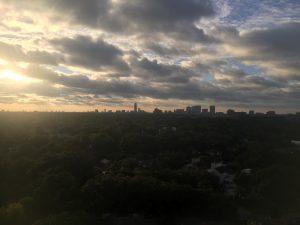
On Saturday, some of the other Nakatani Japanese fellows and I volunteered to help those who suffered greatly from Tropical Storm Harvey through the Rice Harvey Action Response Team (R-HAT). The volunteers met on campus, and then a bus drove us to Crosspoint Church which was assessing where the volunteers needed to be sent. At Crosspoint church, we underwent training, which basically was just watching a 10-minute video clip on how to demolish a house. My fellow group members included Tianyi, who is a Chinese international student and a very good friend of Alex Hwang’s (a Nakatani US fellow) and Natsumi’s (a Japanese graduate student and an alumnus of the 2016 Tomodachi STEM program), and a family of 3 whom all I met for the first time that day. We then were assigned a family to help, gathered some supplies we may need, and headed off to our mission. The home of the family we were assisting underwent flooding as high as 20 cm. They had finished demolishing their house earlier that week (after a flood all of the sheetrock walls, carpet, and flooring must be removed and thrown away so the studs and beams in the flooded home can dry out and not mold), and were getting ready to move out of the house. We helped them move all their possessions from the garage out to the yard, and then under the mother’s directions moved them to either the pile of trash or to their car. A wonderful girl from our volunteer group, despite the fact that she is only 14 years old, was very smart and capable, which impressed me. She knew what she needed to do and was very helpful (maybe more so than me)!
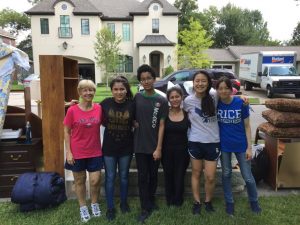
After our mission was accomplished, we went to help another family across the road, who were very good friends of the first family’s. Most of their belongings were still inside the house, and they needed help in moving them all into a truck. Some of us helped move the boxes full of their possessions into the truck, while me and Tianyi mostly helped in wiping all the furniture clean before they were moved into the truck. During the process of demolishing the house, which happened earlier that week, dust and paint from the wall got all over their belongings. So, we helped wiping them all off, including all the delicate electronics they had. This turned out to be more of an endeavor than I first anticipated, as their father was an engineer and had a surprising number of gadgets. After the truck was full and no more could be piled into, we cleaned the floor as much as possible. Although the families should be exhausted, they kept their spirits high which amazed me. I do hope to go volunteering again because there seems to be a lot more that needs to be done around Houston, which is a city I have come to like.
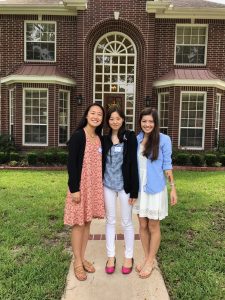
On Sunday, I went to church with Tianyi and Savannah. The church and service was more modern than any I had ever attended, which was nice. There was also a bible study by Dr. Torre, a Rice faculty, and many of the participants were Rice students. Later, Dr. Torre invited all who wished to come over to his home for lunch. There were fifty or so people at lunch, which was prepared by the most hospitable and wonderful lady Shireen, whom is Dr. Torre’s wife. I met with and talked to many Rice undergraduates there, which I do not normally have the opportunity to do, as I am normally working with graduate students. They were all kind and I had a very nice time.
This week, while I was caged inside our hotel, I had the fortune to skype with Dr. Nishihara, who is a Japanese researcher working at Harvard University. My “only” other girl classmate at my school in Japan met Dr. Nishihara through a school programme and kindly introduced her to me, as Dr. Nishihara specializes in bioinformatics, which is what we are majoring in. Dr. Nishihara earned a PhD in Epidemiology from a Japanese university, but strongly felt the need to be able to comfortably use English, as all of the state-of-the-art research is presented in English at conferences and papers, and had always been looking out for the opportunity to study abroad. When she was an associate professor, and she fortunately was granted the opportunity to study in the US as a part of the university’s exchange programme. There, she realised how different graduate school was compared to those in Japan. This may be over simplifying, but she said that if you take the necessary classes and do research for an amount of years, you could basically receive your PhD in Japan. In the US however, you would need to take very demanding courses that assigns 20 hours worth of homework, and it feels like you really “earned” your PhD. Seeing graduate students working hard and learning so much, and the fact that Dr. Nishihara herself did not have a proper education in computational biology as her PhD was in another field, made her decide to pursue a master’s degree in the US, which she is still working towards while working full-time. For the same reasons, she also encouraged me to earn my PhD abroad if I wished to become a competent researcher.
Regarding the research environment in the US, she said that the data here is significantly more open than those in Japan. This is of great importance and almost critical, as bioinformaticians cannot work without data, which is typically genome sequences donated and gathered from millions of people. She also told me that although many researchers at the hospital she works at are M.D./PhDs, researchers from STEM may also succeed as well if they were good at what they do. The gender ratio in bioinformatics seems to be 1:1, and that in epidemiology being 8:2, with the majority being women. This was surprising but encouraging news for me, as in Japan the researchers in the same fields would be predominantly male. Another significant difference between the two countries were that in Japan, bioinformaticians seems to be looked down at, as mere technicians, but that bioinformatics is really “hot” in the US and there are also many researchers in the field. Industries like those in Silicon Valley seem to be very interested in hiring bioinformaticians as well. I knew that bioinformatics is more popular in the US, but after I came here, I realised that it was much more popular than I had thought. In Japan, very few people have ever heard of the word “bioinformatics” including some professors in Biology. But here, when I tell people that my major is in bioinformatics, almost everyone in STEM knows it.
Another fact that surprised me is that when giving birth to children, it may be easier to slow down in Japan than in the US. I had the impression that Japan was one of the most difficult places to have a child if you had a fulltime job, so this was very interesting. Apparently, you can only take a maximum of 3 months off from work in the US, while the same would be about an year in Japan.
- For more on this, see the section on Working in the U.S. on our Life in the U.S. resources page.
As I wrote in an earlier report about talking to Dr. Nishikawa, I am very interested in Immunology but am still not sure whether it would be the best choice. I took this opportunity and talked to Dr. Nishihara about my interests hoping for some insight. To my delight, she said that immunology has “come back” these few years, and that it is regaining popularity rapidly. Moreover, many grants seem to be awarded relating to immunology in the hope of curing cancer or developing effective vaccines. This, and the fact that bioinformatics seems to be appreciated in the US was very heartwarming for me, and I was very glad that I was granted the opportunity to talk with Dr. Nishihara.
Research Project Update
This week, as I was not able to go to lab, I mostly read papers and tried to understand the concepts in biophysics that were all new to me by doing a lot of Googling.
While I was reading, I saw many papers written by Dr. Wolynes and Dr. Go. I was surprised to learn that Dr. Wolynes is actually working at Rice right now, and that my mentor is collaborating with a student from his lab. He proposed the Principle of Minimal Frustration, which is widely supported and argues that natural proteins are designed so that the frustration between atoms are minimal, thus contributing to the protein’s stability.
Dr. Go, to my surprise, turned out to be Japanese. He proposed the Consistency Principle, which Dr. Wolynes’ theory, and thus the whole research field, is built on. I believe that his theory states that if the protein itself is stable, it is also energetically easiest for it to interact with other proteins.
At this point, I do not understand much of the difference between the two theories, which indicates that my understanding of them is not good enough yet. I have finally realised that what my mentor is doing is more related to computational biology and biophysics. I may ask my mentor for some introductory books in this field, because I am very new to this field, and during my readings, I had the impression that I am missing some things about the basic concepts of this field.
Because Japan seems to do excellent research in biophysics, I have also been reading in Japanese, especially about the works of Dr. Go and Dr. Kitao, a University of Tokyo professor.
Question of the Week
Why is Houston so green, and are the other cities in the US equally green as well?
- Climate. Houston is in a sub-tropical zone that gets a lot of rain; therefore, plants and trees grow easily here and require almost no care once you plant them. The high water table means plants and trees can easily get water at a very shallow depth through their root systems. In truth, people in Houston spend more time cutting back trees and plants when they get overgrown than they do trying to get them to grow. Plants or trees that require a cold winter freeze don’t do as well in Houston because we don’t have the change of season they need to go through their natural growth cycles.
- Other areas of the U.S. vary by their region/climate. The U.S. is huge and Texas is the second largest state in the entire country; so there are many different climate zones within the same state. This can be true of many states in the U.S. West Texas, the Southwest, and Southern California are very dry and arid so much less green. In the parries of the Midwest U.S., the land is very fertile but does not have a very deep layer of fertile soil; so, crops grow well but large trees sometimes can only take hold along rivers or streams as there isn’t enough fertile soil/water for them to grow everywhere.
- There are vast forested regions in the U.S., and indeed the entire Northeastern part of the U.S. was covered in forests before the colonists and settlers cut down the trees for farmland and industry in the 1700s and 1800s. The U.S. is huge, and the climate of a region/city and the features of the region/state/city can vary greatly.
- More densely populated cities, such as Boston and New York tend to have fewer trees though there are usually large parks and green spaces set aside for public use. Less densely populated cities tend to have more green spaces/trees (depending on climate) since they can spread out more and use land not just for buildings and streets.
- For more on this see the section on Geography & Regional Differences in the U.S. on our Life in the U.S. page.
Week 04: Reflections on English Language & Life in the U.S.
On Tuesday, my first day back in lab after Harvey, I attended a lecture by Prof. George Philips with my mentor. The lecture was in biophysics and specifically about protein structures. As my mentor’s, and thereby my project, is related to the virus protein’s structure, the lecture was relevant. I believe I understood about a quarter of it, which is honestly just about what I expected. My knowledge in physics is very poor, and the last time I learned it was when I was a sophomore. Naturally, this lecture demanded a higher level of understanding in physics than what I held, so I doubt I would have gotten much more out of the lecture even if it was in my mother tongue. Still, I did have to take an extra fraction of a second to translate each of the technical terms into English, especially the ones in physics, for my brain to make sense out of them. This was hindering my understanding, and made me yearn to be able to register them in English, just the way they were spoken. I assumed this was one of the reasons why Prof. Kono encouraged students to come to the States as early as possible: so that they will have an easier time understanding science in English and would not face as much difficulty in language. The less advanced you are in your education or career, the less complex the terms and ideas will be surrounding you. Personally, I have resolved to read more scientific material in English, as in the past my readings in English were mainly restricted to novels.
Another thing that I promised myself was to learn more physics. Even during my readings for my project, I have painfully registered how important physics is, and that learning it would give me so many more research options to pick from. I am especially interested in learning more about statistical mechanics.
As I have mentioned in a prior report, technical terms such as names of amino acids or enzymes have proven to be rather difficult for me to use in conversation; as I do not know how to pronounce them in English. I would have to give it a few tries to get the right pronunciation, or kind of trail off the word or sentence in a questioning tone hoping that my counterpart would kindly guess what I am trying to say. I believe not knowing the pronunciation, or maybe even the translation for a word, would prove an obstacle for me when I listen to lectures, as I experienced during Prof. Philips’ seminar. One solution for this that I have come up of is to watch YouTube videos that explain certain concepts. This would hopefully be easy enough for me to make it a habit.
Outside my lab, I mostly have lengthy conversations with friends from church, people I met while volunteering, and the Uber drivers who sometimes are super chatty. I have an easier time talking to people that I can be relaxed with. For people who would demand respect within Japanese culture, such as a professor, I have a more awkward time talking with in English. In a prior report, I noted that I sometimes do not know how I am culturally expected to react or what to say during a casual conversation. I understand that in the US, relationships with superiors tend to be more relaxed compared to Japan, where we recognise hierarchy more rigorously and respect towards it permeates throughout our culture and language. It seems easy to mistake that there are no forms of respect or deference toward elders or your bosses. I believe that how you talk to your close friends, must be different to a graduate student you met for the first time. However, I do not know how different they should be and that my attitude towards them are probably overly polite right now, I am trying to learn by listening and observing.
As for how people react and respond during a casual conversation with their peers, I have plenty to learn from as the members of my lab are very close, and have many conversations both related and unrelated to research in the student office where I spend most of my time.
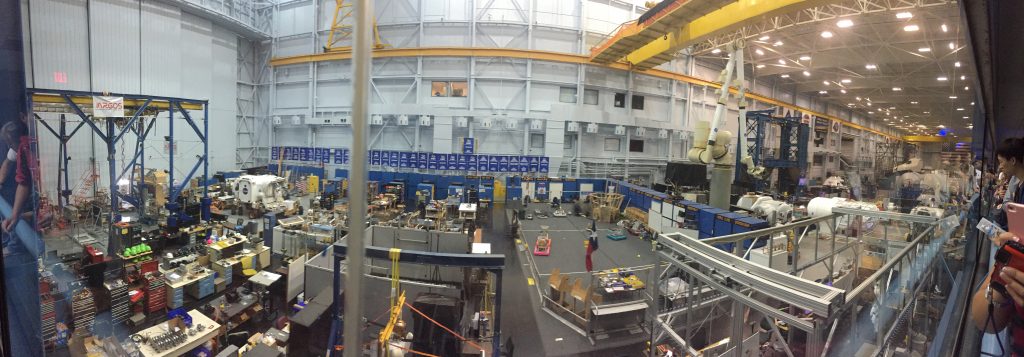
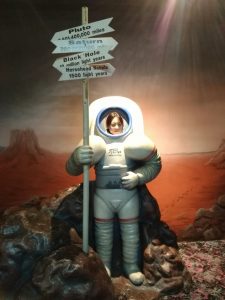
On Saturday, we were finally able to go to NASA: Space Center Houston, a trip we were all longing to go on but had been postponed because of Harvey. My knowledge of Houston prior to this program was that they had NASA, and almost nothing else. This famous phrase you repeatedly hear in movies is hard to forget: “Houston, we’ve got a problem” from the movie Apollo 13. Johnson Space Center was huge and the buildings were spread out on the vast land they owned. In fact, a large portion of their land seemed to have been donated by Rice University. NASA had many exhibits that both children and adults may enjoy. I felt that I could spend a whole weekend studying the exhibits and learning the history of human space exploration. The pure passion for humankind stepping out into outer space represents a curiosity especially profound in our kind, and is also what drives scientists to explore the unknown. NASA provided tourists with two tram tours; the “red tour” that took us to the astronaut training center, and the “blue tour” that goes to the mission control center we so often see on movies. This time, I went to the astronaut training center. This center is used not only for training astronauts but also for developing new technologies. From an upstairs corridor that ran along the enormous room, we saw many impressive gadgets of all sizes. Although it seems to be a workspace for engineers, we unfortunately were not able to see anyone actually working, as it was a Saturday. I could write several pages about my experience and still not be able to convey my excitement so to sum up; NASA was just amazing. It did not fail to meet my expectations in the least, but rather to exceeded it. I would definitely wish to visit again, and hopefully go on the blue tour which I did not have the time to do so this time.
Later that day, I had dim sum with friends. The food was close to what I am used to having, which was very comforting. But the highlight of the dinner was not the food but the people. Our group included Japanese, Chinese, and a Korean, so it was very interesting comparing our cultures. How a presumably common culture in origin developed differently in each region over the centuries, and how they are rapidly changing due to westernization was interesting.
Research Project Update
In my prior reports, most of what I mentioned was about the theories. People were busy settling down as it was the beginning of a new semester, and then Harvey made an unexpected visit. This week however, I was able to spend more time in the lab.
Our lab is focused on the Adeno-associated virus (AAV), which is a non-pathogenic virus, and is a prime candidate as a vector for gene therapy. The project I would be taking part in is aimed at determining whether the computational predictions calculated by AWSEM-MD and the Frustratometer is legitimate in viral capsid proteins as well. If so, researchers may efficiently modify capsid proteins to enhance favorable traits for therapeutic application, without disturbing regions crucial to the virus’s life cycle. In other words, they would know where not to touch.
Prior research done by my mentor and others, have, using the computational models presented above, identified several characteristic amino acid residues that either contributes to either stabilise or destabilise the proteins assembly. Residues that contribute to the capsid’s stable assembly is best to be left alone and not modified.
Currently, we are working on confirming the predictions in vitro for the group of residues that presumably stabilises the assembly, and the control group. We do this by replacing the previously identified residues with electrostatically neutral ones through site directed mutation (SDM). First, we design the primers, which means that we specify the exact DNA sequence that would result in such amino acid replacement. A primer is a small fragment of DNA, and we order them online. We then transfect bacteria with the primers and the plasmid that encrypts the genetic code for the virus protein. And amazingly, in some bacterial cells we may extract a plasmid with our intended mutation. This is the general flow od SDM as I understand it.
Then, we send the plasmid with specific mutations for sequencing. This means that we confirm that the plasmid actually has the specific mutation, by reading the DNA sequence. If the results were supportive, we will then transduce cells with the plasmids, to try and evaluate the effect the mutation had to the virus’s function. As of this week, we went as far as to send the plasmids for sequencing, and await the results.
What we do in lab is pretty straightforward, and similar to what I have experienced before during basic lab courses. My mentor has multiple ongoing projects, which gives me an opportunity to observe a multitude of techniques. I particularly enjoy watching her tending to mammalian cells, as they are more sceptical to contamination and stress, and requires careful work and attention. In fact, my mentor’s, and apparently many of the other lab member’s, cells seemed to have died or are dying, possibly due to stress from being frozen during Harvey.
On the other hand, the theory behind the computational models is perplexing. As I have mentioned in previous reports, many of the concepts used are those in biophysics or even physics, which I am not at all familiar with. I sometimes feel “frustrated” (which is actually a key concept in protein conformation and appears often in my readings) with myself struggling with basic concepts and not seeming to make progress. However, the silver lightning is that after all my readings which seemed to have taken me nowhere, I vaguely feel that I have come to understand a little more of my initial readings from which I started. Writing this report has helped me organise what I do and do not understand as well. For the following week, I will try not to think of how little time I have left before I need to explain everything at the poster presentation, and try to make the most of my time here.
Question of the Week
Is it possible to finish your PhD program early? In Japan and in my field, I feel like that most grad students graduate in 5 years. People may also graduate in 4 years, in which case they would be perceived as a very capable and successful researcher. However, grad students here say that their program is a 5/6-year program, and that they need to stay here at least that much. Do even the most competent students need to complete the required years before graduating, and what is the rationale to such requirements? Is this unique to Rice or common in many programs across the country?
- There is no minimum required time to complete your PhD for most programs in the U.S. Rather, there is usually a 7-year maximum where, if you haven’t finished by then, you need to get approval to continue in the program.
- Students who are highly motivated and who’s research projects go well may be able to finish more quickly but other students may take longer; it really varies by field and student. Five years is the goal I would say for most students; but in fields like applied physics six year can be the norm. This is due to the nature of the research projects (they can take a long time to get results unique/innovative enough for a PhD dissertation) and because students are funded for the duration of their PhD they don’t have as much economic incentive to finish early. Rather, they may spend their final 5th or 6th year writing their dissertation and using their spare time to look for a job as a post-doc or in industry since they will still be paid during that time by their advisor.
- However, if their advisor is low on grant funds that can motivate a student to complete because the professor may say “I can only pay you for another six months so you really need to work hard to finish and defend your PhD by that time”. Professors won’t fund you indefinitely so at some point, students who may be ‘lingering’ do get a little nudge/push to move on to the next stage of their career.
- Also, if you have already completed a master’s degree in the same field before starting your PhD it may not take as long (maybe 3 – 4 years for the PhD) since much of your coursework may have already been completed.
- The best thing to do is to ask professors and graduate students in your preferred field what the average ‘time to completion’ is for students in that particular program. Even in the same field, the answer may vary by university/program.
Week 05: Research in the U.S. vs. Research in Japan
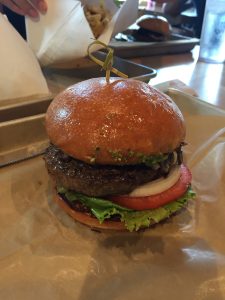
The difference between the labs in Japan and the US seemed to be as explained during the orientation programs. However, learning it from talks was entirely different from actually experiencing it. Naturally, I have only been at one lab in the US, and I have not belonged to a Japanese research lab to date so I cannot generalise. But I would share some of my experiences here, for someone who this may benefit. Please note that these are my personal thoughts – your experience (even in the same lab) may be different. Each lab itself is different and lab groups/projects change/vary from year to year as people come and go.
My lab was in a word, very communicative. People would ask each other how they were, and what their research plans were for the day. They would talk about things both related and unrelated to research. I feel that they being able talk to each other easily about fun things, and being very close to each other, helps them to ask one another questions or talk through issues they are facing in research. For example, when the cells kept dying after Harvey there was a lot of talk, and answers about what to do from those whose cells were doing better.
I also feel that the communicative atmosphere contributes to the good teamwork and collaboration seen here. There are multiple ongoing projects, but I feel that everyone is roughly aware of which stage everyone else is in, and what they are doing. And if someone wanted to try a new technique for their project, they would know who to ask, and would get very helpful answers. I also saw a rotating grad student ask a lab member who wasn’t their mentor some questions and they were given a very detailed answer, until the rotating student fully understood. Everyone was always open to helping others.
One thing that is hard to miss, is how flexible the lab hours were. Each member worked different hours: some came early and left early, while others would come in late and leave later. I often hear that not a few labs in Japan have core hours in which you have to be in lab. Moreover, I feel like many students come to lab at 9 am, and leave at around 7 pm or later in Japan, whilst here, many people would leave by 6 pm. Efficiency, we see here, is a very big difference between the two countries. My mentor was particularly efficient, and did not spend much time in the wet lab.
My lab had four undergraduate students besides me, and they helped the graduate students on a varying scale of independence. I wondered why this was as the same is not common in Japan, and asked my mentor. She explained that having undergraduates and working as a team made her more productive and was rewarding. Prof. Suh being very enthusiastic towards education seemed to promote this as well.
Results seemed to be valued highly in research. A postdoc who earned her PhD in Canada said that the graduate school she attended seems to be more focused on education. More emphasis was put on training the students to become competent PIs by giving them presentations opportunities and checking up on them frequently, as opposed to immediate results. This, I thought was very interesting.
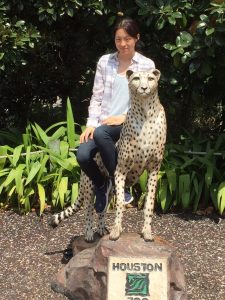
Something that was surprising to me was that more than half of the students in bioengineering at Rice will go into industry upon graduation. Some students said that they might try a few years of postdoc and if they find a good opportunity, they would go into industry. This is very different in Japan. The environment I am in may be rather extreme because I am in science and not engineering, and my university traditionally focuses on research, but most people would pursue a position in academia once they earn their PhDs.
Speaking with many graduate student here has made me want to earn my PhD here. Graduate schools in Japan seem monotonous, but here it seems rather cool. The benefits of studying here are that there are more labs here that have more funding and that the lectures are taught by well known experts of the field. At the BRC, there were even weekly seminars held by each program (so there were at least 3 seminars weekly) where the speakers came from across the country. On the other hand, many undergraduates I met did not wish to or were unsure of going to grad school. I am still not sure of what to do in my future, but going to grad school abroad seems to be a more realistic option now than before. I will quote my mentor’s wise words: “You have to want a PhD, because you want a job that requires it. Earning a PhD is not the goal.”
I will definitely miss the very friendly atmosphere here. People beaming at a stranger and greeting them when passing by is very heartwarming. It makes me want to pass on the joy to the next person. I will also miss the coffee house where you could fill your tumbler with coffee for just 95 cents (my favourite was the hazel nut coffee!). In fact, I believe I will miss everything here but two things: how hard it is for you to get around town without a car and the blazing sun that makes your skin hurt. I have never felt more pride in our excellent subway system back in Tokyo.
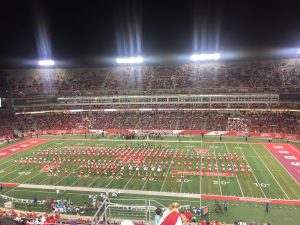
This week, besides research, we all went to the Rice Owls vs University of Houston Cougars football match. This was my first time to watch a football game in a stadium, and to be honest I did not think that a college football match would be a big deal. I was surprised to see the number of people at the stadium and how excited they were about the upcoming match. Even when I was at a bookstore in Rice Village earlier that day, I saw several people wearing Rice T-shirts and talking about the match that night. The match was interesting, but I it would have been more exciting if I was familiar with the rules and my eyes were good enough to track the fast-moving ball. What I enjoyed the most was actually the marching band performance during the half time break. I myself was a part of a marching band through elementary school to high school and experienced both the band and the color guards (who dance with the flags), and had watched many videos of the performances at football games. It was great being able to finally watch it in a stadium!
Final Week in Research Lab
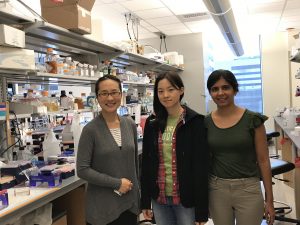
During my last week, I had the opportunity to watch other grad students perform some techniques I had not yet observed: injecting tumors into mice, and purifying viruses using iodixanol. I had experienced the latter method for protein purification, but knowing the band being extracted contains viruses made the process so much more very exciting to me (Aren’t viruses so cool?). The project using mice was a different one from my mentor’s, so it was interesting to learn about them as well, on top of learning how to handle mice.
Upon coming to this lab, I thought there would be a series of special techniques to handle viruses. It turned out that a large portion of the methods used were quite similar to what I have already experienced in a basic biochemistry lab course I took back at home. However, it was all the more exciting for me because there were actual viruses in the solutions. I very much enjoyed observing my mentor perform wet lab experiments because her hand work was very neat, careful and precise. There were a lot to learn from her. Moreover, I learned that work outside of wet lab is equally if not more important. Not to mention planning your experiment and organizing data, but learning about new methods or theories and looking out for dots to connect seemed to be of great importance even for grad students. It may be because my mentor’s project was half computational, but I felt that the theory and planning was much more important than I assumed.
Question of the Week:
The students in STEM here at Rice are very different from those at my home university. The students at the Uniersity of Tokyo, and probably at other universities as well, are very nerdy and perhaps rather socially awkward. During my short stay here, I have not met anyone nerdy, and I feel that most students are very friendly and talkative. This may be because I am in computer science back home, and bioengineering here, but I was wondering why this may be.
- Since there are more than 3,500 universities and colleges in the U.S. universities don’t have as strong a ‘student profile’ as they do in Japan. What you are seeing is more of the culture/personality of Rice where everyone is very open and accepting and encouraging of others. Rice also promotes the idea of work/life balance for students, faculty, and staff so everyone is encouraged to pursue things outside of research/academics too.
- However, at the same time, Rice can be a very competitive environment and closer to exam times (mid-terms of the semester and at the end of the semester) all students hunker down in their rooms/colleges or the library for long study sessions. The Rice student moto is ‘Work hard – play hard’ and the student body definitely exhibits that.
- Also, colleges in the U.S. accept students not based on exam scores alone but also based on their entire application, resume, personal statements – the ‘entire package’. This means they are looking for ‘well-rounded’ students whose past experience leads the admissions committee to believe they will do well at Rice not just in terms of academics but also in terms of campus life too.
- Additionally, when you apply for a job they don’t just hire you because you graduated from a certain university or program. The prestige and rigor of that university/program can be a plus but, here too, they hire you based on your entire package – your individual past research or work experience, cover letter, interview, etc. They are not only looking for people who have the technical skills but also people who have the communication, teamwork, interpersonal skills, and motivation/drive to do well and grow within the company. Even if you are the most technically qualified, if the hiring committee things you are not a ‘good fit’ personality or teamwork wise for the project team/group/position you may not get the job.
- So, the idea of being well-rounded and having balance between academics and other parts of your life is inculcated in how we accept people into universities in the U.S. and also how we hire people for jobs.
- About Houston and Rice University
- See ‘Rice Ranked #1 for Quality of Life’
- Education in the U.S.
- Career Resources for Science & Engineering Students
Week 06: Final Week at Rice & Research Poster Presentation
Research Poster Presentation
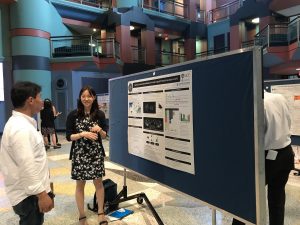
This was the first poster presentation I participated in. It was, looking back, not as terrifying as I expected. Prior to the presentation, I made my poster and practiced presenting to it. At our poster presentation seminar, Prof. Moran advised us that we should give an overview in about 90 seconds, and that it should be easy enough for our grandmothers to understand. Explaining our research, which usually requires complex terms and abstract theories, in simple words proved to be a hundred times more challenging to us than we anticipated. I came up with a concise explanation that I was quite comfortable with, and which was approved by my mentor. That night, which also happened to be the evening before our actual presentation, we practised presenting with each other. My audience which included chemists and engineering friends, turned out to not understand the basic structure of viruses, which was the most basic concept of my research that stood upon. I obviously assumed too much of my audience. My friends pointed out that I should start more from the basics, and to focus on the big picture. The audience at the actual presentation would also be from various backgrounds, so this was very good practise.
The poster session was more relaxed than I expected, and it was easier to explain my poster compared to a power point presentation, because I could make sure that my audience was understanding me as a went through my poster and adjust the level of specificity accordingly. For example, some of my audience were English teachers to whom I emphasised the big picture (curing cancer!) to, whilst to biology professors I explained in-depth the cool model and its biophysical theory to. I was actually surprised at how much people seem to have understood the model and ongoing approach taken to assess it – Rice students are super smart! All in all, I enjoyed talking with many people, and was pleased that more people hopefully got to know about our cool reserch.
After going through the process of preparing for the presentation, I have realised a couple of things. First of all, writing down key points in the poster made me aware of the gaps in my understanding of the theories. In the future, I would try to explain things in my own words when learning new concepts to help me really understand them. Another thing I have learned is the importance of being able to explain one’s research project in simple words so that the general public can understand. Science, I believe exists to improve the lives of the whole of humanity and more. Therefore, scientists should endeavor to share with the community our work and the implications it has for a better future in easily understandable words. I wish to improve this skill myself. I believe I could do so by explaining about the cool things I learn at school to my friends and family, which I have been neglecting recently due to its tediousness. From now on, I will try not to be so lazy!
Project Title: “Applying Computational Models to Predict Capsid Protein Functions in AAV”
The Frustratometer, a computational model developed by Prof. Peter Wolynes’ lab and based on the principle of minimal frustration in protein conformations, was applied to calculate the stability of amino acids constituting the viral capsid in hope of efficiently generating predictions on the effect of artificial mutations, prior to costly in vitro experiments. We are now evaluating the in silico predictions’ credibility through series of in vitro assays. Site directed mutation is used to produce mutated viruses, which are then sequenced and cloned to produce an ample amount of virus for further assays designed to evaluate the capsid’s stability. As to date, thermal stability assays are being conducted for a third of the mutations, and cloning is in progress for another third. The transduction rate for some mutations did not drop as predicted upon introducing mutations that supposedly destabilises the capsid. Further assays will be conducted to evaluate the effect of mutation in detail. If the model may in fact be applied for AAV, virus beneficial for therapeutic means would be engineered more efficiently, in less time consuming and costly way.
Return to Top
Week 07: Visit to Lehigh University & Return to Japan
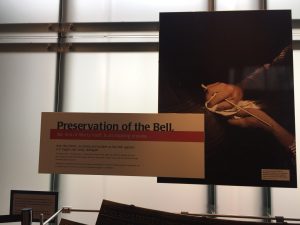
The area of Philadelphia we were in was a small section of the old city; the Historic District. I appreciated how the buildings where crammed together, and the old existed beside the new; it was similar to what I was accustomed to seeing in Tokyo. Houston, in comparison, was a relatively new city and all the buildings were spread out. In Philadelphia, we went to see the Liberty Bell, which represents the Independence of the United States of America from Great Brittan. The park represented liberty, and the democracy we take for granted today. It made me appreciate anew the freedom of life I enjoy and take for granted today. A quote I saw, on a panel about the measures taken to preserve the Bell, at the museum in which the bell was exhibited particularly struck me: “And, like liberty, as strong and durable as this Bell appears, it is fragile and easily damaged.”

Lehigh University was beautiful. The campus was situated on a mountain and the older buildings seemed to reflect the wisdom accumulated inside its walls throughout the years. The panel discussion given by Lehigh professors was very informative, and we were able to ask practical questions about graduate and research life in the US; questions that we came across during the five weeks in Houston, and most of which we had not even thought of before in Japan. I could feel that some of us were really getting ready for studying abroad for graduate school. Thanks to the amazing Lehigh international affairs team, we were also fortunate enough to meet with Dr. Kathrin Zippel, the author of the book “Women in Global Science”. This was a fascinating read as it took a unique approach that questioned the role of women in international collaboration across STEM. Dr. Zippel herself was most kind and generous, and it was a pleasure having the opportunity to talk to her.
On our last night in Lehigh and in the US, with a couple of my friends I went to a Celtic festival which was held in Historic Bethlehem. I happened to have learned Irish dancing as a child, and was a member of a Celtic music club during the first two years in college, so I enjoyed the festival very much. We listened to a rock band’s performance which played music that arranged Irish traditional tunes, and was very cool indeed.
What I appreciate most about being back in Japan are the konbinis and public transport; the two things I missed the most while I was away. My first impression of Tokyo is that it was smelly. In Tokyo’s defense, this turned out to be because fall had already arrived here, meaning that the stinky ginkgoes were everywhere. I also felt that the advertisements seen everywhere around Tokyo were rather crude. My friend who is originally from the Kansai region mentioned to me earlier that the advertisements in Tokyo were aggressive. Being outside of a culture I am so used to seems to have given me a new, slightly more objective perspective.
Final Report & Tips for Future Participants
After returning to Japan, I told my family that Houston and Rice was a very friendly place. They asked me whether I enjoyed my summer, which I absolutely did. This seems to satisfy them the most. I also mentioned to my mother that I now have a better idea of what I want to do after graduation, and that I wish to go to graduate school abroad. Interestingly, she didn’t seem surprised.
When I went to give my professor an omiyage from NASA, he asked me how my summer was. I told him that I really enjoyed my research at Rice, and that attending graduate school in the US now appeals to me. How the people are communicative and the many opportunities to attend seminars from profound researchers is enticing.
If I were to talk to a future employer about my summer’s experience in the US, I would say that the most important thing that I achieved is a better understanding of myself. Living with someone besides my family for six weeks has made me re-examine values or habits which I thought were a norm (Note: I did love my roommate!). With help from the self-discovery activities provided by the Lehigh faculty as well, I now have a better idea of what my personality is, and what I need to live happily. Adaptability, and stress coping methods I honed may also be something I would talk to my employer about.
Something that surprised my friends is my telling them that engineering is cool. People who know of my love for theories, or those who are merely aware that I belong to the school of science even, were curious about this. Other things I would mention is how many women there were in STEM research, and that the US graduate schools in itself is cool as well.
Before participating in this program, I was doing some job hunting activities. Now, I do not think I will actively continue with this. One of the reasons why I was looking for a job is because graduate school and the life after that did not appeal to me. Now, I have more hope. Science is still exciting, just like how it captivated me all day when I was younger. If the situation in Japan for women researchers does not change, I could go abroad. Another thing I wish to do this year: to join a lab!
Tips for Future Participants
For future Japanese fellows, I would encourage them to make the most of their wonderful time in Houston. If there is any opportunity to try something out, it does not matter whether you have a tad bit of homework to get done, just go for it! I personally wish I had the courage to contact more labs to visit, and to try out Zumba.
Last but not least, a huge and sincere thanks to everyone that made this extraordinary summer happen!
Follow-on Project
As a follow-on project, with the help of my fellow University of Tokyo participants, I plan to display an exhibit at our school library about the program and the posters we made. We plan to do this at the library which is at the campus mainly used by freshman and sophomores. Therefore, I hope this would be an effective way to promote the Nakatani RIES program to younger students.
